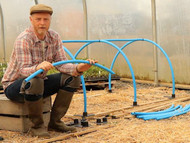Raised Bed Covers
Raised beds are better for growing vegetables because they raise them off the ground level, protecting them from foot traffic and creating a more comfortable working height. Raised bed protection covers increase the uses of your planter and ensure greater growing success rates. There are four main types of cover you can add; Plastic, mesh netting, bird & butterfly netting and garden fleece, all held securely in place by a support frame.
A raised bed cover can consist of a domed structure resembling a mini polytunnel, consisting of a wooden frame and plastic tubing to make the crop cover support hoops. Quickcrop provide simple kits to build raised bed covers which can be either ordered as a full kit or as individual components.

Should I Cover My Raised Beds?
The advantages of raised bed covers include:
- Frost Protection: A fleece covering can trap warmth and insulate your crops when the temperature drops. Horticultural fleece can insulate seedlings from temperatures down to -3 or -4 degrees. At the same time it allows light and water to penetrate, and is light enough that it won't damage or interfere with the growth of young seedlings. Fleece can also be used to ease the transition when moving plants from the polytunnel or indoors to outside in the garden.
- Weather Conditions: Raised bed covers can provide protection against the elements. Weather can be unpredictable, even during the traditional gardening months - whether it's hailstones, heavy rain, or strong winds.
- Pest Protection: Plastic and fleece covers will discourage garden pests from interfering with crops. Micromesh covers can protect against smaller insects like aphids, carrot flies or cabbage root flies.
- Extending the Growing Season: With a polythene raised bed cover, you can create a small microclimate for your raised bed: it's effectively a mini-polytunnel and (as below) has the same overall structure and design. This will allow you to get a head start on the growing season in early spring, as well as to grow later in the year.
What Can You Cover Raised Beds With?
Plastic covers are generally made from high quality clear polythene, the same kind used in larger polytunnels. This provides a complete barrier between your plants and pests, harsh weather or animals, while still retaining heat and humidity. Using a clear plastic cover on your raised bed will increase the soil's temperature and create a humid atmosphere, enabling you to start growing earlier in the year (and extend the growing season later on too). To create a mini polytunnel, just attach the poly cover to a mini tunnel frame or cloche hoops and attach to a raised bed. The mini polytunnel can also be used on beds inside of an actual polytunnel; this way you can benefit from a double glazing heating effect.

Micromesh is an ultra fine garden mesh netting that offers the best insect protection for plants. It effectively keeps garden pests like carrot flies, flea beetles, and aphids out while allowing air and water in. A micromesh cover doesn't have to be removed for watering or applying a liquid plant feed. When the weather heats up a plastic cover may no longer be required, replace with a good micro mesh cover to keep pests away and prevent scorching if the weather really takes off.

Fleece covers for raised beds protect plants from pests, animals and the elements. Most importantly fleece insulates them from frost and colder conditions down to -5 degrees, while still allowing light, air and moisture in to circulate. It is especially good for getting an early start for vegetable plants or for overwintering. It can also be used year round to protect against heavy rain, biting winds and strong sunlight, insects, animals and pests. Garden fleece is very popular among UK vegetable gardeners, as it is reusable and can be set up in a matter of minutes to keep you ahead of our changeable climate. Fleece can be placed over seed beds without damaging tender young seedlings. The lightweight mesh is easily pushed up by emerging plants.
Fleece is a good option for covering your raised beds in winter if you plan to grow overwintering vegetables or herbs. This will work best if combined with other soil-warming measures, as fleece and solar heat alone may not be enough to keep the soil above outside temperatures. Fleece can be heavy duty or it can be made of lighter material; the latter will allow for more light penetration.

A good raised vegetable bed cover should be dome shaped to resemble a mini polytunnel. This shape allows extra headroom for plants as they grow. Large cloche hoops or our mini polytunnel frame are perfect for achieving this shape.
Cloche hoops can be pushed into the soil of the raised bed or fastened to the sides. Our Quickcrop mini polytunnel kits come with a frame made from curved tubing. These tubes fix into the base, which can then be attached to a raised bed via a hinge for easy opening. Any cover can be used with either method. Use:
- plastic for a mini greenhouse effect
- netting for a pest protected vegetable bed, and
- fleece for the ultimate season extender.
